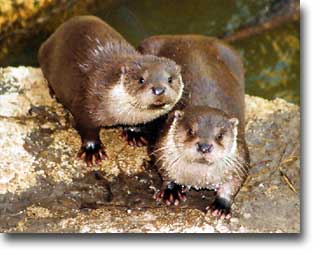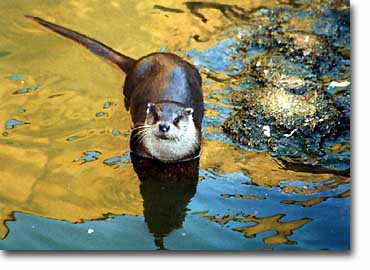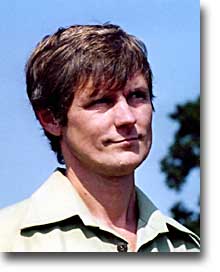Saving Otters,
Saving the Environment
(Any time you see a link, you can click it for more
information on that word or topic)
What's it all about?
An organization called the Foundation for Otters was created in January,
1995 by a Hungarian named Pal Gera.
He started this group mainly to protect otters
and wetlands
in Hungary and throughout Europe -- but not only that. Through his efforts
to get people involved in the protection of otters, he has helped increase
public support for environmental protection in general. He works to help
educate and involve the public in these matters.
What's the Problem?

Otters have almost totally disappeared in Western Europe,
and their numbers are slowly decreasing today all over Europe. Poaching
is on the rise, and otter populations are fragmented and isolated.
What's Causing this Decline?
Today, the main causes of declining otter populations in
Western countries are the destruction of wetland habitats
and water pollution. There are still many otters in Central and Eastern
Europe, but their numbers are decreasing at a dangerous speed.
Hungary's role in saving otters and their habitats is very
important, because the protection and growth of new otter populations
in the Carpathian Basin (an area of Hungary) are the keys to re-establishing
otter populations in the West.
If protection is well-designed in Hungary and Czech Republic,
otters will be able to repopulate the West, and pressure can be applied
to Western governments to restore wetlands and improve water purity.
Where are the Otter Populations of Europe?
There are five different large isolated groups of otters on the European
continent:
1. British Isles: otters are fairly rare in most parts of England.
2. Northern Europe: otters are disappearing rapidly in this area, mainly
in the southern parts.
3. Southwestern Europe: otters can be found on the western coasts of
the Iberian Peninsula and France.
4. Western Europe: Otters have disappeared; small numbers of tiny,
isolated groups can be found.
5. Eastern Europe: the largest single connected population is here,
although even these otters are declining.
Pal conducted surveys of otter populations in several parts of Europe.
According to his results, there are between 1500 and 2000 otters living
in Hungary and in the Czech Republic. In Western Europe the whole otter
population includes about 700 to 800 otters.
There are several causes for the decrease in otter populations: a main
one is damage to their habitats and environment from growing tourism.
Poaching also plays a major role in the disappearance of otters, as do
new fishing equipment and methods. Destructive water management, water
pollution and acidification
of waters also play a large part.

Where are they Protected?
The European otter is protected in almost every country where it appears,
but there are exceptions. In Albania, for instance, otter hunting is allowed
in winter. In Finland and Norway, otters are protected, but shooting otters
around fishing ponds is legal.
We could also mention Ireland, where otters are protected as well, but
because of traditional reasons people can get permission to hunt otters
with groups of dogs.
Or there is Belorussia where otters are not protected at all. In Bosnia-Herzegovina
the protection is only seasonal; otters may be hunted in winter.
What About Otters in Hungary?
Otter appearances are frequent in Hungary. This has two main reasons:
1. The species became protected in 1974.
2. Several hundred fishing ponds were created in the past twenty years
in the southwestern and eastern parts of Hungary. In the southwestern
regions of Hungary, hunting has a long tradition. People earned their
livings from hunting 300 years ago.
Industrialization vs. Environmental Protection
After the 2nd World War everything became owned by the state in Hungary
(in 1949) until 1989. Otters could reproduce unhampered. No one cared.
However, as communist industrialization
resulted in the pollution of rivers, the number of otters gradually began
to decrease in natural wetlands. People were taught that environmental
protection would slow economic progress.
In the 1980s, as the communist regime began to collapse and a
more open political situation evolved, the government prepared an Environmental
Law which did not specify punishments for violations and which legalized
higher pollution levels than in Western countries. This Law was not changed
until 1997. From 1989 to 1997, there was no effective control over the
destructiveness of privatization.
Between 1989 and 1993, a newly born environmental movement emerged in
Hungary, but it wasn't very effective. It slowly disappeared in the following
years due to too much competition for the same limited resources and too
little cooperation. Each loses its strength in the fight for money and
for acceptance by the state and society at large. Hungary therefore remains
an exception, even in Central Europe, in its low level of environmental
awareness. Privatization and economic growth are often priorities which
crowd the environment out of the public’s awareness. Many Hungarian businesses
are bitterly opposed to environmental regulations.
The new 1997 Environmental Law is of the highest European standard, but,
as it was created during the change of governments, many of its regulations
were not enforced because new state leaders (elected in 1998) did not
authorize the changes. The state still provides very little support for
the environment, and even this is gradually decreasing.
The Story Behind the Foundation for Otters 
Pal Gera, and his Foundation for Otters, are fighting to
raise awareness of environmental protection through his work with otters
and wetlands. The Foundation for Otters is the only organization in Hungary
which concerns itself specifically with otters and their habitats.
Pal has discovered that the endangered otters are an effective
symbol of environmental degradation throughout Europe, and can be used
to mobilize public support for wetlands conservation, the maintenance
of “green
corridors,” and the fight against illegal poaching. Pal also focuses
on otters because they sit at the top of the food chain and are therefore
important indicators of environmental quality.
To achieve his goals, Pal Gera worked to involve volunteers, children,
university students, experts and environmentalists, landowners, fishing
and hunting organizations, and politicians, all in a national network.
The success of his Foundation for Otters network is a great example for
other social change movements in Central Europe to follow.
The Foundation for Otters program also features several unique components
for wetland and otter protection including:
-
national survey methods
-
an Otter Park and Ambulance
-
a conference series
-
compensation to fishermen and others for damage caused by otters
-
a strong and successful lobby
-
and youth education programs.
Volunteers do all the work of the Foundation for Otters. A three-member
board organizes and manages the different activities and fifty volunteers
participate in the Foundation's work throughout the country.
top of page | next
page
|













